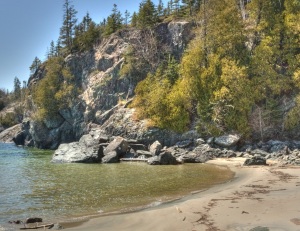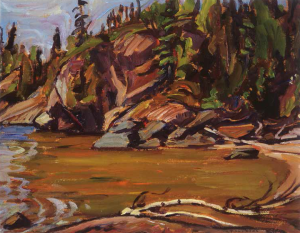Painting Detective – Group of Seven – Wawa
Art Detectives – Sleuthing for the Group of Seven
by Back Roads Bill
The Hardy Boys and Nancy Drew are detectives. They are sleuths, motivated to solve crimes.
We appreciate Sherlock Holmes, the fictional detective created by Scottish author and physician Sir Arthur Conan Doyle, for the astute logical reasoning used to unravel difficult cases.
 ‘Following in the Footsteps of the Group of Seven’ is not fiction it celebrates the inspiration of others and why we have favourite panoramic views. This coffee table book traces the work of Jim and Sue Waddington who have a passion for locating the actual sketching sites for artworks by members of the Group of Seven, the renowned group of landscape painters.
‘Following in the Footsteps of the Group of Seven’ is not fiction it celebrates the inspiration of others and why we have favourite panoramic views. This coffee table book traces the work of Jim and Sue Waddington who have a passion for locating the actual sketching sites for artworks by members of the Group of Seven, the renowned group of landscape painters.
Nearly a century ago, the group of artists travelled into northern Ontario and farther afield to capture the beauty that lay just beyond the outskirts of Canada’s urban areas. Armed with sketchbooks, brushes, and paint boxes, they set off into the heart of the wilderness with the singular purpose of interpreting the landscape in a modern mode of artistic expression.
Juxtaposing the original artworks with photographs taken by the Waddington’s where these Group members camped, canoed, portaged and sketched, the book reveals iconic images of the northern Ontario landscape and the real inspiration behind them. It provides insight into the working methods and distinct personalities of the artists through the circumstances surrounding their trips—climate conditions, the physical challenges faced, methods of travelling, and choice of location.
You have the opportunity to observe how the Canadian landscape has changed in the past century by comparing the artistic interpretations by the Group in the early to mid-twentieth century with photographs from the Waddington’s “labour of love.”
Sleuthing as an Avocation
In July 1977, Jim and Sue Waddington set off on their own expedition to discover the places that inspired these artists. Determined to locate, document, and photograph the actual landscapes that inspired the cosmopolitan group including, A.Y. Jackson, Franklin Carmichael, Arthur Lismer, Lawren Harris, A.J. Casson, J.E.H. MacDonald and Tom Thomson. Their research more than a course in art history, it is provenance exemplified by dogged determination travelling the back roads and waterways.
“People suggested to us that the painters would head out and paint from memory, and that these portrayals weren’t real,” Sue says. “But that is not the case.”
The Waddington’s began a 36-year journey — tracking down clues, deciphering bits of information, tracing historic portage routes, and exploring — all with the purpose of finding the very spots that gave birth to the work of the Group of Seven.
In 1976, she already had a hobby – rug-hooking. For a class project she decided to copy a Group of Seven work, an A.Y. Jackson  painting called Hills. They recall how they packed up their two kids, Nina and Michael, and actually went there. Would they be able to find the same view A.Y. Jackson rendered on canvas in 1933? And they did.
painting called Hills. They recall how they packed up their two kids, Nina and Michael, and actually went there. Would they be able to find the same view A.Y. Jackson rendered on canvas in 1933? And they did.
For Jim and Sue the interest in travelling and tromping through deep bush for painting sites used by the Group of Seven was a perfect hobby for a couple wanting to keep active. “Years ago it dawned on me that we never knew where the Group of Seven painted,” says Jim. “We knew they painted in the Canadian North. But where exactly? Each painting is a new puzzle. Sometimes you can get an idea where someone was from the title of a painting. But that often doesn’t help you find the exact spot.”
Some locations are easier to solve than others. Typically the Waddington’s take many miniatures of paintings known to be from an area they are heading into. And in some cases the landscape revealed few changes.
“We knew this painting” — ‘Twisted Pine’ (1939) by Franklin Carmichael — “which we were sure we’d never see the tree alive,” said Jim. Then someone in the area told them: “We know all about it. Do you want to go and see it?” They did. “It looks very much now as it did then, about two metres high; it hadn’t grown very much at all.”
In 1995, they came across a small boulder they’d seen in a photo of Franklin Carmichael sitting on a rock and sketching high above Grace Lake in the western side of Killarney Provincial Park.
“We knew we had to find and sit on that rock,” says Sue. “That was a fun thought.”
So they scoured the hills, there was a photograph and the painting — still no rock. Maybe it’s the wrong hill, they thought. Maybe they’d taken the wrong trail. The mystery was only resolved when a friend, scurrying down the hill, came across the boulder in question. The next year the Waddington’s returned to the area and with friends hauled the rock up the hill by block and tackle. The rock is now there where Franklin once was.
“Each winter we think about our next trip and what paintings we want to hunt for,” Jim says. “Sue reads up on an area and on the artists’ attachment to it and I study the topographic maps.”
Follow in the Footsteps
Where exactly did the Group of Seven paint their magnificent landscapes? Here is one example of a painting in the Wawa area by A.Y Jackson near where he once owned a cottage.
For ‘Shoreline’ (1955) drive south of Wawa on Highway 17; five km; and find the road heading west to Michipicoten Harbour. Drive about 1 km you will come to an intersection. Turn right (north), drive to the small wooden bridge; that is Silver Falls; drive on past the cemeteries, up the steep hill and down to Lake Superior. You will come to the municipal beach. At the shoreline walk north all the way to the far end of the beach and up and over the rocks to the tiny cove. Take along page 89 of the book or the photo. This location is WGS 84 Zone 16 T E 0659744 N 5313795 or N47° 57’ 27.1” W84° 51’ 36.8”. You have arrived. You get the measure of the artist. Momentarily you’re in the very space that produced the work.
“Following the Group has taken us all over Canada. They found so many beautiful and interesting landscapes. The country in so diverse and they have shown this to us. The painters realized that this country couldn’t be properly represented in the traditional way. Of course there were pastoral farms with cattle grazing that they could have painted but they realized that there was so much more. To show this raw beauty they had to go out into the woods. They had to experience it. By camping where they camped, hiking up the hills that they climbed, we, in some way, have learned to appreciate this beauty as they did.”
What’s next for the art detectives now retired? “Sue and I would very much like to go back to the Arctic. There are many more locations to find and photograph.” The couple has solved almost 200 puzzles. “We are going to keep doing this until we can’t move anymore,” Jim says.
So if you are looking for gift ideas you could choose the Waddington’s coffee table book; Google: Art Gallery of Sudbury (to order a signed copy). A sleuth is also one of the English language’s trove of strange collective nouns, used to describe a group of bears.) Like various media forms there’s a difference in the artists’ motivation and how we choose to appreciate their creativity.
.GPX File